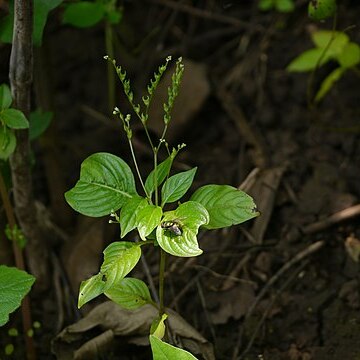Annuals 10--50 cm tall, glabrous except for sparsely appressed pubescence or puberulence on young leaves, inside of corolla lobes at base, and fruit. Stems erect, simple or branched at base; branches 4-angled to narrowly 4-winged; internodes 1.5--6 cm. Interpetiolar stipules ± triangular, 1--2 mm. Petiole 3--10 mm; leaf blade ovate to narrowly ovate, 4--7 X 1.5--3 cm, membranous to papery, base cuneate, apex acuminate to obtuse, lateral veins 5--7 pairs and inconspicuous. Inflorescences terminal or axillary, 6--10 cm, many-flowered; peduncle to 7 cm; bracts and bracteoles narrowly elliptic, 1--2 mm. Pedicel very short. Calyx lobes ovate to triangular, ca. 1 X 0.5 mm. Corolla white, ca. 3 mm, tube ± as long as lobes; lobes narrowly ovate, apex obtuse. Stamens inserted at or near base of corolla tube; anthers broadly ovate, apex at ± middle of corolla tube. Ovary ovoid to subglobose, smooth. Style shorter than ovary, free to base; stigma capitate. Capsules ca. 3 mm in diam., pincerlike due to incurved apical horns. Seeds ellipsoid, ca. 0.5 mm, concave on one side, smooth. Fl. May-Oct.
Erect annual herb, 50–300 mm high; branches glabrous. Leaves with stipules broadly triangular, c. 1 mm long; petiole 5–10 mm long; lamina ovate to elliptic, c. 25 mm long, c. 15 mm wide, truncate or cuneate to attenuate (often abruptly so) at base, ciliate, subacute, with appressed-pubescent hairs on both surfaces or glabrous. Inflorescence terminal and axillary, lax; internodes usually longer than flowers or fruit; flowers shortly pedicellate to subsessile. Calyx 1.2–2 mm long; glabrous. Corolla 1.5–2.5 mm long; tube 1–1.3 mm long, hairy at mouth, white or occasionally mauve. Gynoecium 1–1.4 mm long; stigma bilobed. Capsule 2-horned, c. 3–3.5 mm long. Seeds obscurely verrucose, c. 0.5 mm long.

